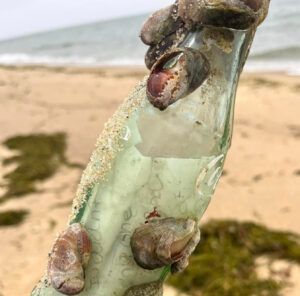 HYANNIS – Parents who use e-cigarettes are largely unaware of the dangers of their children ingesting liquid nicotine, a recent study shows.
HYANNIS – Parents who use e-cigarettes are largely unaware of the dangers of their children ingesting liquid nicotine, a recent study shows.
The study,conducted by the Washington University School of Medicine, surveyed 658 parents at 15 Midwest pediatric clinics. One in five had tried e-cigarettes, and one in eight had family members who regularly used them.
Of those, 36 percent reported they didn’t lock up the liquid nicotine, the ingredient that produces vapor when brought to a boiling point in e-cigarettes. The most common place to store the dangerous liquid was in a drawer or cupboard, in a pocketbook or on an open counter—all places where children have easy access.
Unlike most European countries, most containers of liquid nicotine sold in the U.S. don’t come child-proof caps, said John Mendelsohn, MD, room physician and toxicology expert at Falmouth Hospital.
Mendelsohn compared the milligrams of liquid nicotine to kilograms of the average weight of a toddler. He said one teaspoon probably wouldn’t kill a 20-pound child, but it would make them awfully sick.
“They would have discernible symptoms like nausea, vomiting, tachycardia, seizures and altered mental status,” Dr. Mendelsohn said. “Those symptoms would require a trip to the hospital.”
He noted that it wouldn’t take much more than a teaspoon of liquid nicotine to be fatal. And for some kids, that small amount really would be enough.
The draw for children is two-fold.
“Many of these liquid nicotine products are flavored,” Dr. Mendelsohn said. “And not only do they come in attractive flavors, they are packaged with colorful content that would attract a child. Plus you can buy the refills in pretty large quantities.”
Children can also develop a bad rash if their skin came into contact with liquid nicotine. “You have to remember that nicotine was originally used as a pesticide in agriculture,” Dr. Mendelsohn said. “That’s its use commercially.”
A toddler from upstate New York is believed to be the first child to die ingesting liquid nicotine in December 2014, but the numbers of poisonings are increasing rapidly as more people jump on the vaping bandwagon.
The national Centers for Disease Control and Prevention reported that the number of calls to poison control centers due to liquid nicotine increased from one per month in September 2010 to 215 per month in February 2014.
That number is expected to increase as vaping and e-cigarettes hit the mainstream market and gain more acceptance.
Use of e-cigarettes among young adults has increased anywhere from five to 20 times in the last five years, Dr. Mendelsohn said. “So we’re seeing a lot of young people doing this and young people, of course, can have young children.”
The Regional Center for Poison Control and Prevention says that more than 60,000 children end up in emergency rooms every year because they have ingested a poisonous substance. Of those cases, 90 percent happen in the home.
Poison Control offers the following tips to prevent accidental poisoning from any substance, including liquid nicotine:
- Store all poisonous substances in a place where children cannot reach them, and preferably can’t even see them. Children are resourceful climbers, so it’s better they don’t know something intriguing is in the cabinet over the fridge.
- Put all poisonous substances away every single time you use them. Never leave any toxic substance sitting on a counter or table for even a few minutes. In addition to being resourceful, children are quick.
- Discuss the dangers of any toxic substance with your children and then be prepared to answer the inevitable questions about why you are using something that’s toxic, but they can’t.
- Inform guests or babysitters of the dangers of any substances in your house, so they can be on alert when you aren’t around.
- Keep the Poison Control phone number (800-222-1222) on your cell phone or in a place where you can access it easily.
If your child is unconscious or having trouble breathing, call 911 immediately.
By LAURIE HIGGINS, OneCape Health News

























“Of those, 36 percent reported they didn’t lock up the liquid nicotine, the ingredient that produces vapor when brought to a boiling point in e-cigarettes.”
Apparently you have not done your full research on this subject. Electronic cigarettes come pre-filled. Usually containing 24-36% nicotine and made by major tobacco corporations. Personal Vaporizers use liquid that contains nicotine, the nicotine is about 0%-24% of the make-up of the complete liquid, the other parts are Vegetable Glycerin(VG) and Propylene Glycol(PG) and flavorings. The nicotine is sold in concentrate form and added or NOT to the flavored liquid. Most long term vapers are using 3% nicotine per milliliter e-liquid. Often distilled water is used as well as flavorings. Most of the American small mom and pop liquid manufacturers hold themselves to higher standards than the restaurant industry for producing products for consumption.